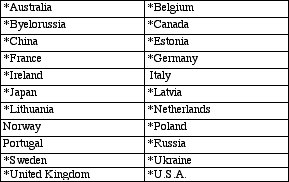|
|
2.5 Activities involving other IGCP projects or IUGS
IGCP 406 began as a successor project to IGCP 328 (Palaeozoic Microvertebrates), which ended in 1996, and is
helping to bring some IGCP 328 initiatives to a productive conclusion. For example, IGCP 406 participants are
collaborating in study of specimens collected under IGCP 328-sponsored field work in Arctic Canada, and IGCP
406 participants (A. Blieck and S. Turner, editors; numerous IGCP 406 participants as authors) are playing a
major role in bringing IGCP 328's final volume to completion and publication in CFS. Research on Severnaya
Zemlya vertebrates and biostratigraphy continues, and publication of the Russian and French volumes (D. Goujet,
editor, for Geodiversitas)on this subject will also further the aims of IGCP 328. IGCP 406 continues to make
good use of the newsletter Ichthyolith Issuesand the Paleozoic MicrovertebratesWWW page, both begun under
IGCP 328, to keep participants informed and to disseminate project news and announcements.
Many participants are also associated with one or more of the relevant subcommissions of the International
Commission on Stratigraphy, especially the Subcommission on Devonian Stratigraphy (SDS) and the
Subcommission on Silurian Stratigraphy (SSS).
2.6 Participation of scientists from developing countries
IGCP 406 has excellent participation from several countries of the former Soviet Union: Russia (including remote
regions), Estonia, Latvia, Lithuania, and Ukraine, as well as from Poland. This year, we had especially good
participation by scientists from remote parts of northern Russia. We also have several active participants from P.R.
China, who are of great importance for helping to solve problems of global correlation and paleobiogeography.
3. Proposed activities of the project for the year ahead
3.1 General goals
Working group members continue to plan for joint research on existing fossil collections and to apply for funding
for field work as appropriate.
1. Final revisions and publication of papers will be completed for a special volume of the Proceedings of Estonian
Academy of Sciences, Geology, treating Ordovician, Silurian and Devonian stratigraphy, sedimentology and
palaeogeography in the Timan-Pechora region.
2. Other major publication projects, including the special Severnaya Zemlya volume of Geodiversitas, and the
IGCP 328 special volume of Courier Forschungsinstitut Senckenberg, will be completed during the coming year.
2. Members of the Canadian Arctic Working Group continue their collaborative studies on Devonian acanthodian
faunas (Canada, France) and Silurian-Devonian heterostracan and thelodont faunas (Canada, Estonia) from the
Mackenzie Mountains, on Lower Devonian vertebrates from the Anderson River (Canada, Germany), and on
heterostracan, thelodont, anaspid, and placoderm faunas from Cornwallis, Baillie-Hamilton, Prince of Wales, and
Somerset Islands (Australia, Canada, Estonia, Germany, Sweden). German colleagues continue to study vertebrates
|
|


 1
2
3
4
5
6
7
8
9
10
11
12
13
14
15
16
17
18
19
20
21
22
23
24
1
2
3
4
5
6
7
8
9
10
11
12
13
14
15
16
17
18
19
20
21
22
23
24



 1
2
3
4
5
6
7
8
9
10
11
12
13
14
15
16
17
18
19
20
21
22
23
24
1
2
3
4
5
6
7
8
9
10
11
12
13
14
15
16
17
18
19
20
21
22
23
24

